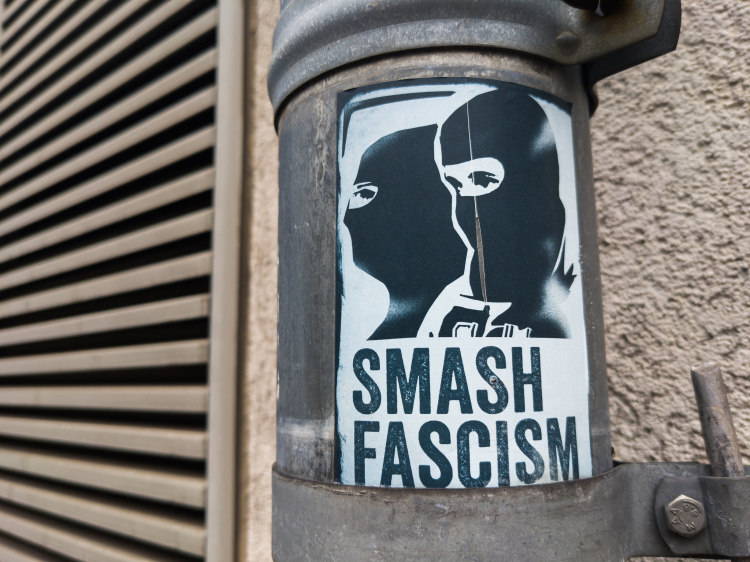Analyzing Europe's Anti-Fascism Movements

Fascism can be described as a form of far-right, authoritarian ultranationalism characterized by dictatorial power, forcible suppression of opposition, and strong regimentation of society and of the economy. Fascism came to prominence in early 20th-century Europe and the movement experienced its first waves following World War I, beginning with Benito Mussolini's National Fascist Party. The ideology was ultimately born out of Italy under Mussolini, and Italian Fascism influenced other subsequent fascist movements across Europe. The word "fascism" comes from the Italian fascio, meaning a bundle or group, and is considered a term for a militant brotherhood.
Professor Giuliana Chamedes is Mellon-Morgridge Professor of European International History at the University of Wisconsin, Madison. She completed an MPhil in European History at the University of Cambridge and a Ph.D. at Columbia University. Her first book, A Twentieth-Century Crusade: The Vatican’s Battle to Remake Christian Europe, came out with Harvard University Press in 2019 and won the Michael Hunt Prize in International History (2020) as well as the Marraro Prize (2019). Her work has been published in the Journal of Contemporary History, Contemporary European History, French Politics, Culture, and Society, and in numerous edited volumes. She has received support for her research from the American Council of Learned Societies, the Mellon Foundation, and the DAAD, among others. She is currently drafting her second book, tentatively titled Failed Globalists: European Socialists, Decolonization, and the Decline of State Welfarism, 1973-2008.
Image credit: Flickr/Marion DossProfessor Chamedes's talk, labeled "Anti-Fascism as a Differentially Mobilizing Ideology: Anti-Imperialism and the Failed Globalization of the European Left, 1935-1979," investigates the endurance of antifascism as a mobilizing ideology from the 1930s through the 1970s. She begins with terminology and historiography, then moves on to the three turning points within Europe's antifascist movements, and ends with their implications. According to Professor Chamedes, anti-fascism in 20th-century Europe could be described as a, "plural, multivalent term encompassing many different political traditions." She goes onto explain that antifascism emerged at three moments of, "crisis and opportunity," as it was a, "laboratory [for] visions of the desirable future society."
Professor Chamedes then suggests that two distinctive varieties of antifascism took shape in the 1930s and endured, with minor changes, through the late 1970s. The two varieties of antifascism were in dialogue but in opposition to one another—and both were mobilizing ideologies: they existed not only in the realm of ideas, but counseled individuals to take action in particular and circumscribed ways. The talk's central contention is that these two strands of antifascism are central to understanding the course of modern European history and the enduring inability of the European Left to connect effectively with large numbers of activists of color on European soil.
The first form of antifascism — Popular Front antifascism — was the child of Western European communist parties, and was adapted and endorsed by the Communist International in 1934. It saw fascism as the leading threat on the international stage and identified it as an anti-democratic movement pushed by reactionary bourgeois interests. It also argued for the creation of a broad coalition between far-left and centrist political parties so as to bring down fascist governments. Popular Front antifascism picked up speed with the Spanish Civil War, had its day in the sun during the Grand Alliance politics of 1944 through 1947, and was dusted off again in the 1970s. This time it conjoined with a defense of individual liberty and human rights and an attack on the Soviet Union. Popular Front antifascism was not born in a vacuum, it was a response to a second antifascist mobilizing ideology, which also took shape in the 1930s.
Image credit: Flickr/Lynn SkordalThis second form of antifascism—anti-imperial antifascism—was brought to life by current and former imperial subjects, many of whom were living in continental Europe. While these figures agreed that fascism was anti-democratic and the child of the bourgeoisie, they emphasized that fascism was at its core an imperial vision based on a commitment to the existence of racial and civilizational hierarchies. For these activists and writers, fascism would only truly be destroyed when European imperialism came crashing down. This anti-imperial antifascism exploded on the global stage in 1935, with the Fascist Italian attack on Ethiopia, and reappeared after 1945, when most European imperial powers failed to give up their colonies and embraced Popular Front antifascism instead, and emerged again in the 1970s under the umbrella of a globalizing Black Power movement.
In historiographic terms, Professor Chamedes suggests that 1) European reconstruction was based on one antifascist myth, at the conscious suppression of another rival form of antifascism; 2) the transformation of the European Left in the 1970s was less radical than many imagined — though its inability to move beyond Popular Front antifascism alienated a new generation of Europeans in ways that would have long-standing consequences; and 3) anti-imperial antifascism — and its relationship to Popular Front antifascism — has been unhelpfully obscured by the historiography, even though it played a shaping influence on the European Left and social movements for at least two-thirds of the 20th century.
Overall, Professor Chamedes provides AUP students with an accessible critical analysis regarding the European Left's failure to successfully mobilize anti-fascism as a popular ideology in 20th-century Europe.









